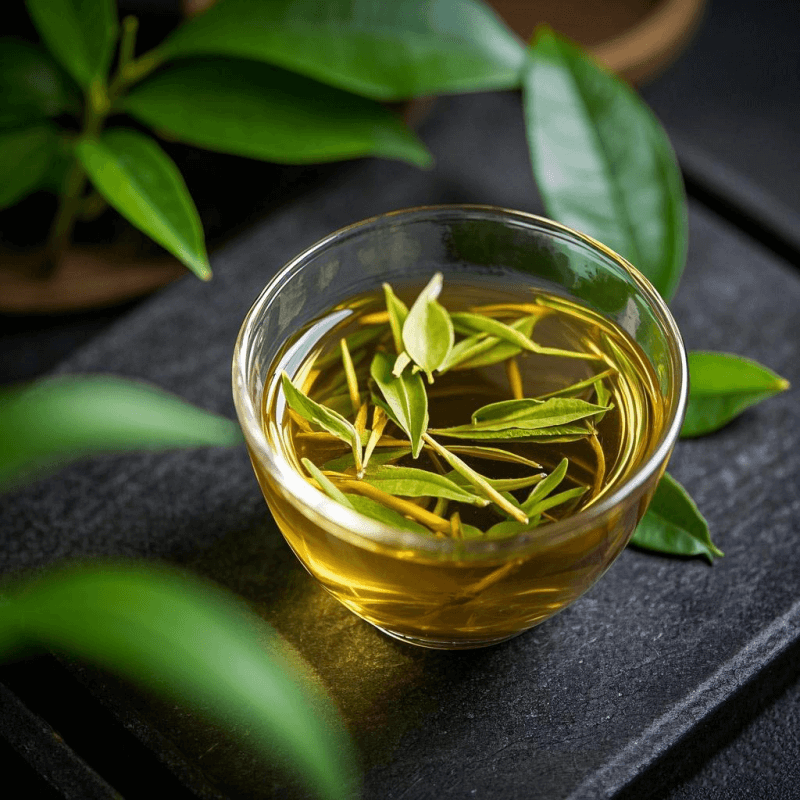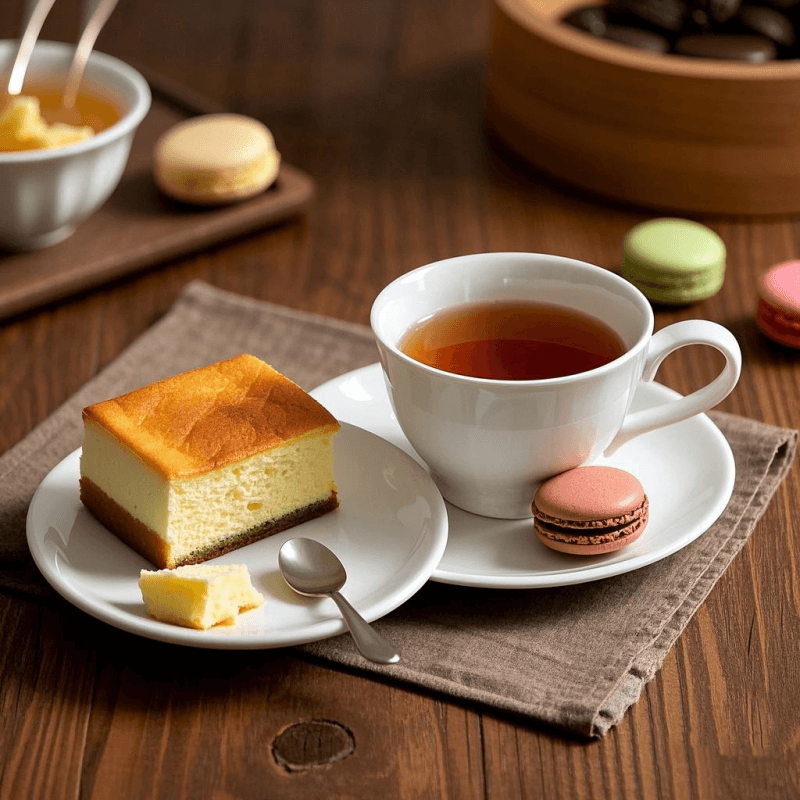Quick Answer
Milk oolong tea is a lightly oxidized oolong, often from the Jin Xuan cultivar, prized for naturally creamy, buttery aromas and a silky mouthfeel. Some versions add flavoring to imitate these notes. Brew with hot—but not boiling—water for a smooth, sweet cup with floral-dairy hints.
Introduction
Milk oolong tea offers a luxurious gateway into the world of premium teas, perfect for those who crave creamy, floral complexity without adding actual milk. This distinctive tea delivers naturally occurring buttery notes through careful cultivation and processing, though flavored versions exist alongside authentic varieties. Understanding the difference between natural and enhanced milk oolongs, plus mastering proper brewing techniques, transforms an ordinary tea moment into something extraordinary.
My first encounter with milk oolong happened at a specialty tea shop in San Francisco’s Chinatown, where the vendor encouraged me to smell the dry leaves before purchasing. The aroma was unlike anything I’d experienced—sweet cream mingled with fresh orchids, so captivating I knew immediately this tea would become a staple in my collection.
What Is Milk Oolong?
True milk oolong originates primarily from the Jin Xuan cultivar, developed in Taiwan during the 1980s. This specific tea plant naturally produces compounds that create creamy, dairy-like aromatics without any actual milk involvement. The leaves undergo light oxidation—typically 20-30%—and are carefully rolled into tight pellets that unfurl beautifully when steeped.
The “milky” character refers entirely to aroma and mouthfeel sensations, not dairy content. Authentic milk oolongs develop these cream notes through terroir, processing techniques, and the Jin Xuan cultivar’s unique chemical composition. However, many commercial versions add artificial flavoring to enhance or simulate these natural characteristics.
When I first warmed authentic Jin Xuan leaves in my gaiwan, the emerging fragrance reminded me of butter warming in a cast-iron pan—rich, comforting, and completely plant-based. The dry leaves themselves carried hints of steamed milk and vanilla, promising the delicate complexity that would unfold in the cup.
Flavor & Aroma Profile

Milk oolong presents a sophisticated flavor matrix combining cream, butter, and steamed milk notes with floral orchid undertones and subtle sugarcane sweetness. Some varieties exhibit tropical fruit hints, particularly when grown in Thailand or other Southeast Asian regions. The “silky” mouthfeel differs from “oily”—it’s smooth and coating without heaviness.
The aroma often proves more pronounced than the taste, creating anticipation with each inhale. The body typically registers as medium-light with surprising depth, while the finish lingers pleasantly with gentle dairy echoes and floral brightness.
My personal tasting analogy: imagine warm cream poured over fresh orchid petals with a whisper of vanilla cake—delicate, comforting, and mysteriously satisfying without overwhelming the palate.
Benefits & Caffeine
Milk oolong provides a gentle energy lift through moderate caffeine content, typically 30-50mg per cup depending on steeping strength. This level offers focus and alertness without jitters, making it ideal for afternoon productivity sessions. Like other oolongs, it contains beneficial antioxidants including polyphenols and catechins, though specific health claims should be approached realistically.
After enjoying two infusions during my typical 3 PM work break, I notice sustained mental clarity lasting about two hours—enough to tackle complex projects without the crash associated with coffee. The gentle stimulation feels more centered and calm compared to the sometimes anxious energy from stronger teas.
How to Brew Milk Oolong (Western Method)
For Western brewing, use 2-3 grams of leaves per 250ml of water heated to 90-95°C. Steep for 2-3 minutes, taste, and adjust timing for preferred strength. An optional quick rinse awakens the leaves and removes any dust. Re-steep the same leaves 2-3 times, adding 30-45 seconds with each subsequent infusion.
Ceramic or glass vessels work best, preserving the delicate aromatics that metal can sometimes mute. Avoid boiling water, which can extract bitter tannins and overwhelm the subtle cream notes.
My perfect combination: 2.5 grams in a 300ml ceramic teapot, 92°C water, 2.5-minute first steep. This ratio consistently delivers the ideal balance of cream, florals, and gentle astringency that makes milk oolong so appealing.
How to Brew Milk Oolong (Gongfu Method)
Gongfu brewing reveals milk oolong’s full evolution across multiple short infusions. Use a 1:15 to 1:20 leaf-to-water ratio in a gaiwan or small teapot with 95°C water. Begin with a quick rinse, then proceed with 10-20 second steeps, gradually increasing by 5-10 seconds: 15s, 20s, 25s, continuing for 6-8 total infusions.
Between steeps, inhale the aroma from the emptied cup—this ritual enhances appreciation of the tea’s complexity. Each infusion offers subtle variations, from initial bright florals to deeper cream notes and finally gentle mineral undertones.
Infusion number three consistently shines for me, delivering what I call “buttered orchid” perfection—the cream notes reach their peak while floral brightness remains vibrant, creating milk oolong’s signature harmony.
Buying Guide: Natural vs Flavored
Authentic milk oolongs feature “Jin Xuan” or specific cultivar names on labels, often indicating Taiwanese, Fujian Anxi, or Thai origins. Expect to pay $15-40 per 50 grams for quality natural versions. Suspiciously low prices usually indicate flavored varieties or lower-grade leaves.
Watch for ingredient lists mentioning “natural flavoring” or marketing copy emphasizing “creamy taste” over cultivar information. Reputable vendors offer sample sizes, allowing you to experience authentic milk oolong before committing to larger quantities.
My vendor selection rule: prioritize shops that provide detailed sourcing information, harvest dates, and encourage questions about processing methods. Knowledgeable sellers who can discuss oxidation levels and cultivar specifics usually stock authentic products.
Storage & Freshness
Store milk oolong in cool, dry conditions within airtight containers, away from light and strong odors. Use within 6-12 months for optimal aromatic qualities. Divide larger quantities into smaller portions, removing excess air before sealing. Avoid refrigerator storage unless extremely well-sealed, as moisture and odor contamination risks outweigh benefits.
I keep my milk oolong in a tin canister inside a dark cupboard, portioning weekly amounts into smaller containers. Over eight months, I’ve noticed the cream notes gradually soften while floral elements become more prominent—still delicious, but different from the initial bright dairy character.
Pairings & Use Cases

Milk oolong complements light pastries, fresh fruit, and mild cheeses without overwhelming delicate flavors. It’s particularly suited for afternoon focus sessions, providing gentle stimulation during creative work or study periods.
My favorite pairing combines milk oolong with lemon shortbread cookies—the buttery tea notes harmonize perfectly with the cookie’s richness while citrus brightness enhances the floral aspects, creating a sophisticated afternoon tea experience.
Personal Notes & First-Sip Diary
November 15th, 3:47 PM: Dry leaves appear tightly rolled, dark green with golden edges. Warming them in my ceramic gaiwan releases immediate vanilla-cream aromatics. First sip delivers unexpected silkiness—not thick, but coating. Flavor starts subtle: sweet cream, then orchid petals emerge mid-palate.
Second infusion intensifies everything—butter notes bloom, tropical hints appear. Third infusion reaches perfect balance. Fourth begins fading. Honest downside: over-steep by even 30 seconds and bitter tannins overwhelm the delicate profile, requiring careful attention to timing.
FAQs
Is milk oolong tea actually made with milk? No, the “milk” refers to natural creamy aromas and mouthfeel from specific tea cultivars and processing methods.
What’s the caffeine level compared to green tea? Similar to green tea, typically 30-50mg per cup, varying with steeping strength and leaf quality.
How is Jin Xuan different from other oolongs? Jin Xuan naturally produces dairy-like aromatics through its unique chemical composition, while most oolongs emphasize floral, fruity, or roasted characteristics.
How many times can I re-steep? Quality milk oolong yields 4-8 flavorful infusions using gongfu methods, 2-3 with Western brewing.
Why does some milk oolong taste perfumey? Artificial flavoring in commercial versions can create overpowering, unnatural cream notes that mask the tea’s natural character.
Western vs gongfu—what should beginners start with? Western brewing offers easier, more forgiving introduction, while gongfu reveals the tea’s full complexity through multiple short steeps.
